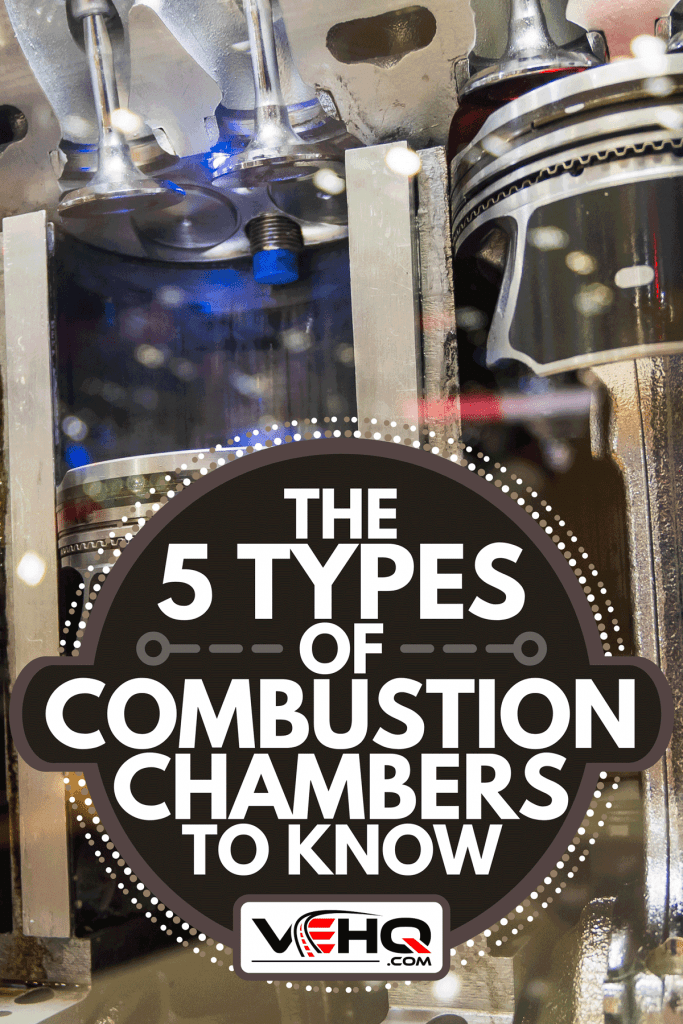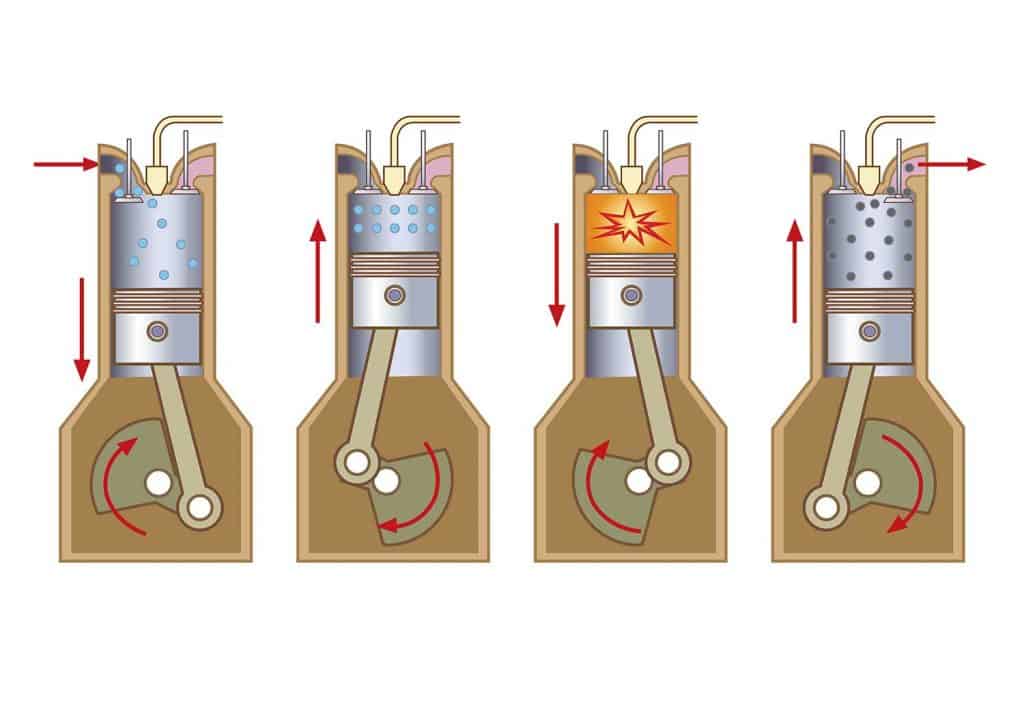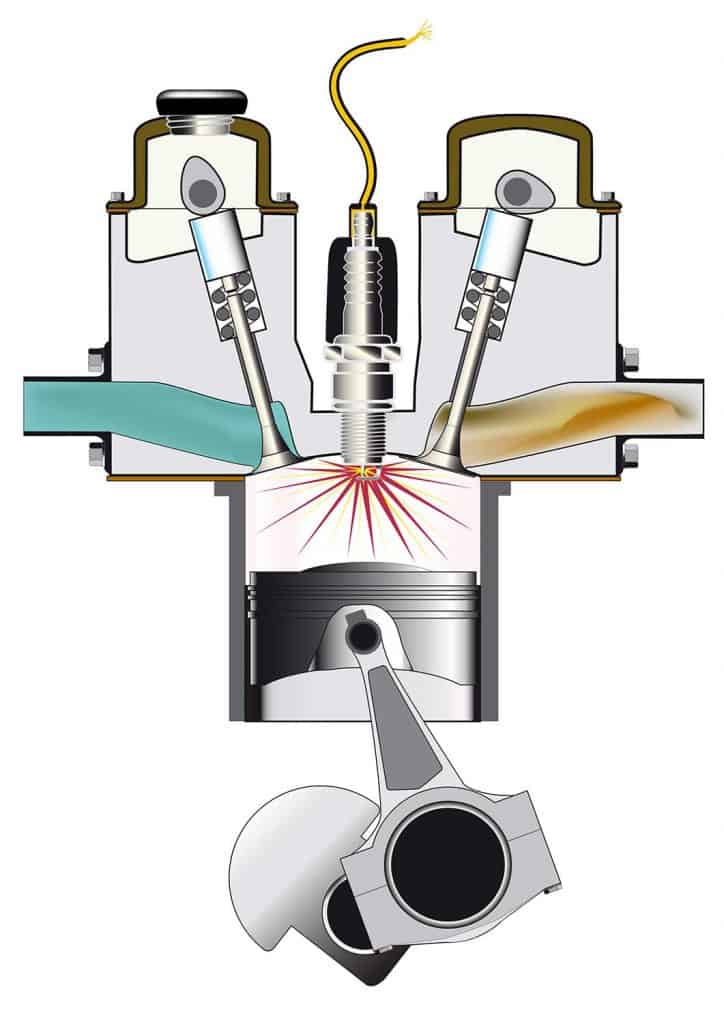When purchasing a vehicle, most people fall into one of two camps: they either want lots of power or great gas mileage. Although many factors determine how fast a vehicle can accelerate while towing a trailer or how many miles per gallon it gets, two of the most important questions, respectively, are: how explosively and how efficiently does the engine burn fuel? To answer these questions, you need to know what type of combustion chamber the vehicle uses. So, what are the different types of combustion chambers, and how do they relate to your vehicle's power and gas mileage? We've done the research, and we have the answers for you!
Every modern car, truck, van, or SUV uses one of these five types of combustion chambers:
- Hemispherical
- Pentroof
- Wedge
- Bathtub/Heart
- Direct Injection (Diesel)
In the remainder of this article, we'll describe each type of combustion chamber, tell you whether it is part of a gasoline- or a diesel-powered engine, and discuss its relative power and efficiency. We'll also explain where the combustion chamber is located, what it does, and which design is the most efficient. Keep reading to learn more!

5 Types Of Combustion Chambers
There are two types of internal combustion engines used in automobiles: the spark ignition (SI) engine found in gasoline-powered vehicles and the compression ignition (CI) engine used in diesel vehicles. Each type of engine, fuel, and air mix together in the combustion chamber and then ignite. This ignition releases the chemical energy in the fuel/air mix, transforming it into mechanical energy that drives the vehicle.
The major difference in the functioning and design of the combustion chambers in the two types of engines is that an SI engine uses a spark plug to ignite the air/fuel mix. In contrast, a CI engine compresses the air in the combustion chamber until it is hot enough to ignite the fuel.

Gasoline-powered cars, trucks, vans, and SUVs have spark-ignition engines. There are four types of combustion chambers in SI engines today, each named for the shape of the chamber when the piston is at the top-center position: hemispherical, pentroof, wedge, and bathtub/heart. All diesel-powered vehicles feature compression ignition engines that use the direct injection combustion chamber.
1. Hemispherical
A hemispherical combustion chamber features a domed cylinder head; so, when the piston is at its highest point within the cylinder, the space between the top of the piston and the cylinder head is shaped like half a sphere.
The intake and exhaust valves are located on opposite sides of the dome, with the spark plug between them at the top of the cylinder head. This arrangement creates a highly efficient airflow with minimal heat loss. Additionally, the placement of the valves allows for larger-than-usual intake and exhaust valves, which increases the engine's maximum power at high RPMs.
Despite its additional power, the hemispherical combustion chamber has two major drawbacks. First, it burns fuel at unusually high temperatures, releasing high levels of nitrogen oxide gases. So manufacturers of engines with hemispherical combustion chambers must also put extra emission controls in place. Second, the hemispherical cylinder head is heavy and costly to manufacture, adding to both the vehicle's weight and cost.
The best-known automobile brand currently using the hemispherical combustion chamber is Chrysler, whose "It's got a Hemi!" commercials launched in 2004. Chrysler continues to tout the Hemi engines on its Dodge Ram pickup truck and Dodge Charger muscle car for the power they provide.
Click here for remanufactured Hemi cylinder head on Amazon.
2. Pentroof
The pentroof combustion chamber is similar to the hemispherical, except the pentroof design incorporates four smaller valves (two intake and two exhaust) rather than the two large valves in the hemispherical design. The intake and exhaust valves sit opposite each other in the cylinder head, forming a V-shape.
The spark plug is located at the top-center of the cylinder head, thus placing it precisely in the middle of the four valves. This allows for quicker combustion and lower temperatures, reducing emissions. The pentroof combustion chamber is also smaller than that of the hemispherical, and with less surface area, heat loss is reduced even further, thus improving gas mileage.
In the pentroof cylinder depicted above, the additional intake and exhaust valves are located directly behind those shown, so they are not visible in the diagram.
3. Wedge
The wedge-shaped combustion chamber has been used by automobile manufacturers for decades and continues to be popular. The inside top of the cylinder head is shaped like an inclined basin, and the intake and exhaust valves sit at an angle so that when the piston is at its top-center position, the space between the piston and the cylinder head looks like a wedge.
This design forces the air/fuel mix downward with great force during the compression stroke, causing a buildup of kinetic energy, which adds to the power released when the air/fuel mixture ignites.
The wedge-shaped combustion chamber is not as efficient or as powerful as a hemispherical or pentroof design. However, it is a solid, time-tested solution that many vehicle manufacturers still use.
Click here for a Toyota cylinder head with a wedge combustion chamber on Amazon.
4. Bathtub/Heart
The old bathtub-shaped combustion chambers of the 1950s have been replaced by the more efficient oval- or heart-shaped chambers, but the basic principles are still the same. The inside top of the cylinder head is shaped like an inverted bathtub, and the intake and exhaust valves sit side-by-side at the top-center, with the spark plug off to the side.
The slope of the chamber walls is gentler than that of the wedge-shaped combustion chamber, so less explosive energy is released upon ignition, but the design makes the bathtub/heart-shaped chamber more efficient than the wedge-shaped chamber. However, the side-by-side position of the intake and exhaust valves results in substantial heat loss.
Chevrolet's LS-1 engines, found in the Malibu, Sonic, Aveo, and Cruze, among others, utilize the bathtub/heart design for their combustion chambers.
5. Direct Injection
Diesel engines in automobiles use direct injection combustion chambers. They employ a four-stroke cycle:
- First stroke: the piston slides down in the cylinder, opening the intake valve and allowing air into the combustion chamber.
- Second stroke: the piston slides up, compressing (and thus heating) the air in the chamber.
- Third stroke: the piston slides partway down, and the intake valve releases fuel into the chamber; it mixes with the heated air and ignites.
- Fourth stroke: the piston slides down, opening the exhaust valve and releasing the byproducts of ignition.
These engines tend to have better gas mileage but less pick-up and power than gasoline-powered engines.
Click here for the new Ford diesel direct injection cylinder head on Amazon.
Where Is The Combustion Chamber Located?
In modern spark-ignition engines, the combustion chamber is located within the cylinder head. The combustion chamber is not a discrete "piece" of the engine; rather, it is the empty space between the inside top of the cylinder head and the top of the piston. The image below may help you to visualize it:
- The cylinder is in the middle part of the image, bounded by two thick gray lines.
- The piston (a solid gray object) is inside the cylinder walls, currently in a "down" position.
- The curved top of the cylinder is the cylinder head.
- Atop the cylinder heads are the intake (blue air/fuel) and exhaust (brown pollutants) valves
- The spark plug is in the middle of the cylinder head
- The space between the top of the piston and the inside top of the cylinder head is the combustion chamber. This is where the air/fuel mix is ignited by the spark plug and burns.

In diesel (compression ignition) engines, the placement of the combustion chamber is essentially the same. The major difference is that there is no spark plug. Instead, as the piston moves upward within the cylinder, it compresses the air in the combustion chamber, thus heating it enough to ignite the diesel fuel.
What Does A Combustion Chamber Do?
The combustion chamber is the space in the engine where fuel and air mix, ignite and burn at a controlled rate and temperature. This process releases the chemical energy in the fuel and transforms it into mechanical energy that powers the vehicle. Each cylinder in the engine has its own combustion chamber, piston, and intake and exhaust valves. In a gasoline-powered vehicle, each cylinder also has its own spark plug.
What Is The Most Efficient Combustion Chamber Design?
Although the concept may seem simple, designing an efficient combustion chamber is actually quite complex. In addition to the shape of the combustion chamber itself, several other factors come into play:
- the shape of the top of the piston
- the shape of the cylinder itself
- placement of the intake and exhaust valves
- placement of spark plug (for gasoline engines)
- overall airflow through the engine
These factors vary from engine to engine, as does the precise shape and size of the combustion chamber itself. So, although we can't pinpoint the most efficient combination, we can identify which combustion chamber tends to be the most efficient.
The pentroof combustion chamber is generally the most efficient design. This is not surprising, as it was designed to incorporate the advantages of a hemispherical chamber while improving efficiency.
- Like those in a hemispherical chamber, the pentroof combustion chamber's intake and exhaust valves are located on opposite sides of the cylinder head, optimizing airflow.
- While the hemispherical chamber can accommodate only one intake and one exhaust valve, the pentroof design incorporates two of each valve, increasing efficiency.
- The intake and exhaust valves of wedge and bathtub combustion chambers are located next to each other, thus reducing airflow and increasing heat bleed-off.
So, the pentroof combustion chamber has excellent airflow, maximum intake and exhaust capacity, and minimal heat loss. This combination makes it the most efficient of the five types of combustion chambers.
In Closing
Understanding combustion chambers can help you know what kind of power and gas mileage to expect from your vehicle. It also helps you understand more about how the fuel system works. And, being able to explain the different combustion processes in gas- and diesel-powered vehicles isn't just a way to impress your friends at parties -- it may also help you avoid being taken for a ride by shady repair shops!
You may also enjoy:





Simple document to follow, full of necessary information
Well explained information though there’s not much diagrams , for learners to fully understand to the fullest.
Well articulated though there’s no much diagrams to make it simple for the learner to understand to the fullest.